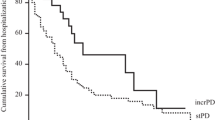Summary
The role of peritoneal dialysis (PD) in renal replacement therapy has been well established. However, there is persisting controversy about the amount of dialysis that is required for optimal outcome. On the basis of the results of clinical studies of patients treated with continuous ambulatory peritoneal dialysis (CAPD), NFK-DOQI guidelines recommended achieving a Kt/Vurea of ≥2.0 per week and a total creatinine clearance of ≥50 l/week/1.73 m2 (low/low-average transporters) to 60 l/week/1.73 m2 (high/high-average transporters). In automated PD, the targets are slightly higher (≥2.1 per week and ≥63 l/week/1.73 m2, respectively). In the DOQI guidelines, renal and peritoneal clearances are assumed to be equivalent; therefore it has been supposed that increasing the dialysis dose could compensate for the loss of residual renal function (RRF). Several retrospective studies analyzed the effect of peritoneal and renal clearances separately and did not find a correlation between peritoneal small-solute clearance and mortality. However, RRF was an important factor influencing mortality of PD patients. The Adequacy of Peritoneal Dialysis in Mexico (ADEMEX) study is a randomized, prospective study that was designed to investigate the effect of PD dose on clinical outcome in CAPD patients. This study also showed that RRF, but not peritoneal clearance, predicted clinical outcome. An increase of PD dose (from 1.8 to 2.27 Kt/V per week) did not improve patient survival or technique survival. On the basis of the result of ADEMEX and some other clinical studies, a combined renal and peritoneal Kt/V of 1.8/week appears to be adequate in most clinically stable PD patients without signs of malnutrition. Nevertheless, there are no patient-survival data on the influence of peritoneal small-solute clearances, which are markedly higher than those recommended in the DOQI guidelines. On the other hand, important determinants of adequate PD include not only small-solute clearances but also middle-molecule clearances, preservation of RRF, careful attention to volume status, treatment of cardiovascular risk factors, and treatment of malnutrition and other comorbidities.
Zusammenfassung
Die Peritonealdialyse als Nierenersatztherapie ist gut etabliert, jedoch ist unklar, welche Dialysedosis für ein optimales Patientenüberleben notwendig ist. Für Patienten an der kontinuierlichen ambulanten Peritonealdialyse (CAPD) empfehlen die NFK-DOQI-Guidelines das Erreichen eines Kt/VHarnstoff von ≥2,0 je Woche, sowie eine Gesamt-Kreatinin-Clearance von ≥50 l je Woche/1,73 m2 für "low/low-average transporter" und ≥60 l je Woche/1,73 m2 für "high/high-average transporter". Für Patienten an der automatisierten Peritonealdialyse (APD) werden etwas höhere Zielwerte vorgeschlagen (≥2,1/Woche und ≥63 l/Woche/1,73 m2). Diese Empfehlungen basieren nur zum Teil auf Evidenz und sind zum anderen meinungsorientiert. In den DOQI-Richtlinien wurden peritoneale und renale Clearance als gleichwertig angesehen. Deshalb entstand die Schlussfolgerung, dass eine Erhöhung der Dialysedosis den Verlust der Nierenrestfunktion in äquivalentem Verhältnis kompensieren kann. In verschiedenen retrospektiven Studien mit getrennter Betrachtung der renalen von der peritonealen Clearance wurde gezeigt, dass nur die renale Clearence einen Einfluss auf die Patienten-Sterblichkeit hatte. Die ADEMEX-Studie ist eine prospektive randomisierte Studie, die den Einfluss der Dialysedosis auf das Überleben der CAPD-behandelten Patienten untersuchte. Auch hier fanden die Autoren, dass lediglich die Nierenrestfunktion das Patientenüberleben beeinflusst. Weiters stellte sich heraus, dass eine Erhöhung der PD-Dosis (wöchentliches Gesamt-Kt/V von 1,8 auf 2,27) zu keiner Besserung des Patienten- beziehungsweise technischen Überlebens führte. Aufgrund der Ergebnisse verschiedener klinischer Studien scheint ein kombiniertes (renales und peritoneales) wöchentliches Kt/V von 1,8 bei den meisten klinisch stabilen PD-Patienten ohne Zeichen einer Mangelernährung adäquat zu sein. Allerdings existieren bisher keinerlei Daten über den Einfluss von Clearances kleinmolekularer Substanzen, die deutlich über den DOQI-Richtlinien liegen, auf das Patientenüberleben an der PD. Neben der Clearance kleinmolekularer Substanzen sind die Mittelmolekül-Clearance, die Erhaltung der Nierenrestfunktion, die Kontrolle der Flüssigkeitsbilanz, die Behandlung kardiovaskulärer Risikofaktoren und auch die Therapie der Malnutrition wichtige Determinanten einer adäquaten PD.
Similar content being viewed by others
Author information
Authors and Affiliations
Corresponding author
Rights and permissions
About this article
Cite this article
Lilaj, T. Adequate peritoneal dialysis – recent aspects. Wien Klin Wochenschr 117 (Suppl 6), 83–88 (2005). https://doi.org/10.1007/s00508-005-0489-6
Issue Date:
DOI: https://doi.org/10.1007/s00508-005-0489-6




